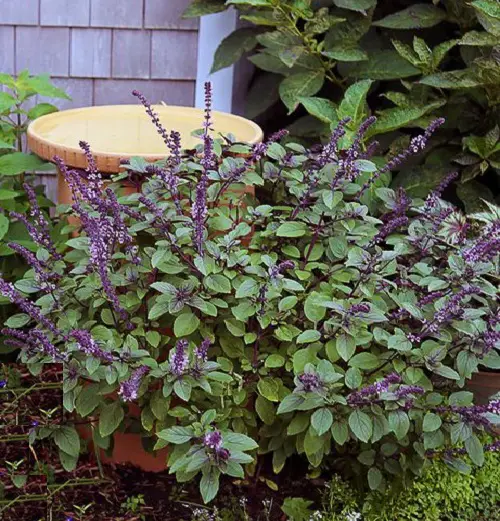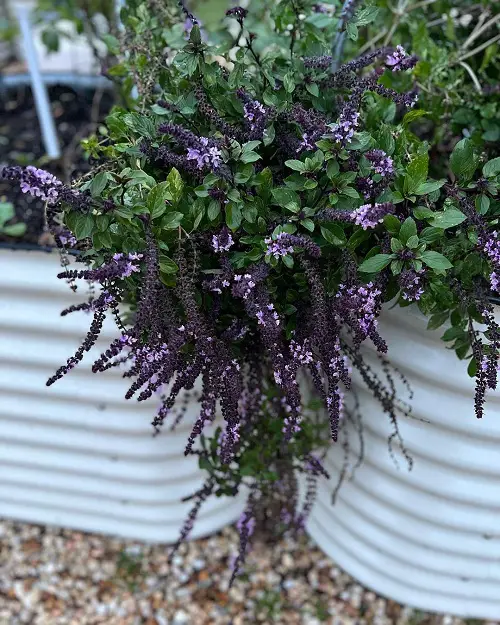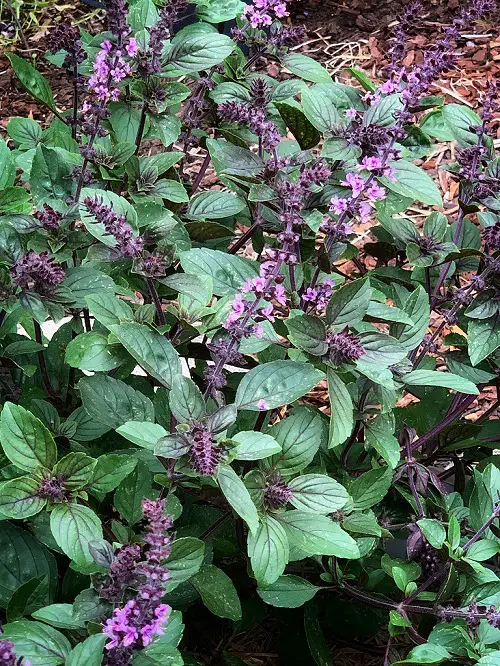Do you want to grow a herb with beautiful flowers? Check out our detailed guide on African Blue Basil Plant Care!

Want a beautiful combination of dark flowers and green foliage? Here are all the details on African Blue Basil Plant Care that will help you grow this stunning herb.
What is African Blue Basil?
Also known as clove basil, African basil (Ocimum kilimandscharicum x basilicum) is a hybrid edible herb popular for culinary or medicinal purposes. It is a cross between camphor basil and a cultivar of basilicum ‘Dark Opal.’
In zone 10 or higher, this plant is a perennial, while it can be planted as an annual in cold climates with warm summers.
USDA Zones: 9-11
Propagating African Blue Basil

African Blue Basil can be planted with cuttings. Use clean, sharp pruning shears and cut 4-6 inches-long tender stems that are not flowered yet. Discard the lower foliage.
Plant them in a well-draining potting mix. Water well and keep the cuttings where they get plenty of dappled light.
When to Plant African Blue Basil?
If you are living in a climate with temperatures between 68-95 F (20-35 C), then you can plant African Blue Basil at any time of the year. If you live in a cold region, plant when the weather warms up.
Requirements for Growing African Blue Basil

Location
Every basil loves to be in sunlight and African Blue Basil is no different. For the best flowers, make sure it gets at least 5-6 hours of sunlight. The more, the better.
Place the plant near a South or West-facing window if you are growing it indoors, and if you have a balcony, keep it there. Remember, lack of sunlight may cause leggy growth.
Soil
African Blue Basil thrives in rich and well-draining soil, with a pH that ranges from slightly acidic to slightly alkaline. You can use any regular soilless potting mix to grow this herb.
Adding compost or plenty of organic matter to the growing medium at the time of planting will help it thrive. A pH of 6.0 to 7.5 is best for it.
Water
The best trick to water this plant is to water it only when the topsoil feels a little dry to the touch. DO NOT water the plant daily. Do not spray water on leaves and reduce watering in cold and wet weather.
African Blue Basil Care

Fertilizer
Fertilize African Blue Basil every 2-3 weeks with half-strength balanced liquid fertilizer.
If you see yellowing leaves, and slow growth, this could be due to Magnesium deficiency. To cure it, dissolve 1 tablespoon of Epsom salt in 1 gallon of water and use it once in 2-3 weeks.
Pruning and Clipping
Regular pruning will result in better and bushier leaves. Always remove basil’s flowers as it allows the plant to direct its energy towards more foliage growth. Also, pinch off the top set of leaves to encourage lateral growth.
Pests and Diseases
Keep an eye on aphids while growing African Blue Basil. You can easily handpick them and squeeze their soft body. In diseases, it’s susceptible to fusarium wilt and mildews. Using an organic fungicide can help you curb the problem.
African Blue Basil Uses
This edible herb has medicinal properties and helps in treating fever, cold, bacterial infections, parasites, and gastrointestinal issues. It also acts as an insect repellant and its oil is used in making bug sprays.
For cuisines, you can try African Blue Basil and lavender pesto, African Blue Basil vinaigrette recipe, and African Blue Basil-infused Chicken & kale Soup.
Storing African Blue Basil
It will be best to harvest the leaves and blooms on the day you plan to use them. If you want to store them, wrap the leaves in a paper towel, put them in a plastic bag, and place them in a refrigerator.



